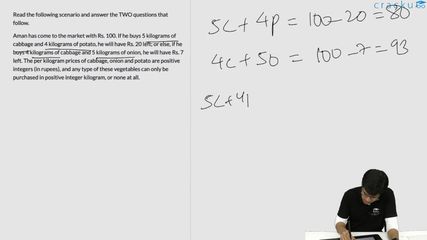Read the following scenario and answer the TWO questions that follow.
Aman has come to the market with Rs. 100. If he buys 5 kilograms of cabbage and 4 kilograms of potato, he will have Rs. 20 left; or else, if he buys 4 kilograms of cabbage and 5 kilograms of onion, he will have Rs. 7 left. The per kilogram prices of cabbage, onion and potato are positive integers (in rupees), and any type of these vegetables can only be purchased in positive integer kilogram, or none at all.
Aman decides to buy only onion, in whatever maximum quantity possible (in positive integer kilogram), with the money he has come to the market with. How much money will he be left with after the purchase?
Solution
Let the price of one kg of potato be P, one kg of cabbage be C, and one kg of onion be O.
we are given the equations,
$$5C+4P=80$$ (i)
$$4C+5O=93$$ (ii)
In equation (ii), we get 3 as the unit digit on the right-hand side. This is only possible with 8 + 5 on the left-hand side.
So, the unit place value of C must be 2, which means that C can have values 2, 12, 22, 32, and so on. The value of O must be an odd number.
Using this information in equation (i), we can see that the value of 5C will always have 0 as its unit digit. Meaning that the value of 4P must also have its unit digit as zero.
This would tell that P is a multiple of 5.
4P can then only be 20, 40 or 60 for C to also have a positive integer value.
If P is 5, C would be 12, giving the value of O to be 9
If P is 10, C would be 8, and this is consistent with our criteria that the unit digit of C must be 2
If P is 15, C would be 4, which is again not consistent with the same criteria.
Therefore, the price of one kg of potato would be Rs. 5, one of of cabbage would be Rs. 12 and one kg of onion would be Rs. 9
Aman can buy a maximum of 11 kg of onions for Rs. 99, leaving him with Rs. 1
Therefore, Option E is the correct answer.
Video Solution

Click on the Email ☝️ to Watch the Video Solution
Create a FREE account and get:
- All Quant Formulas and shortcuts PDF
- 15 XAT previous papers with solutions PDF
- XAT Trial Classes for FREE
